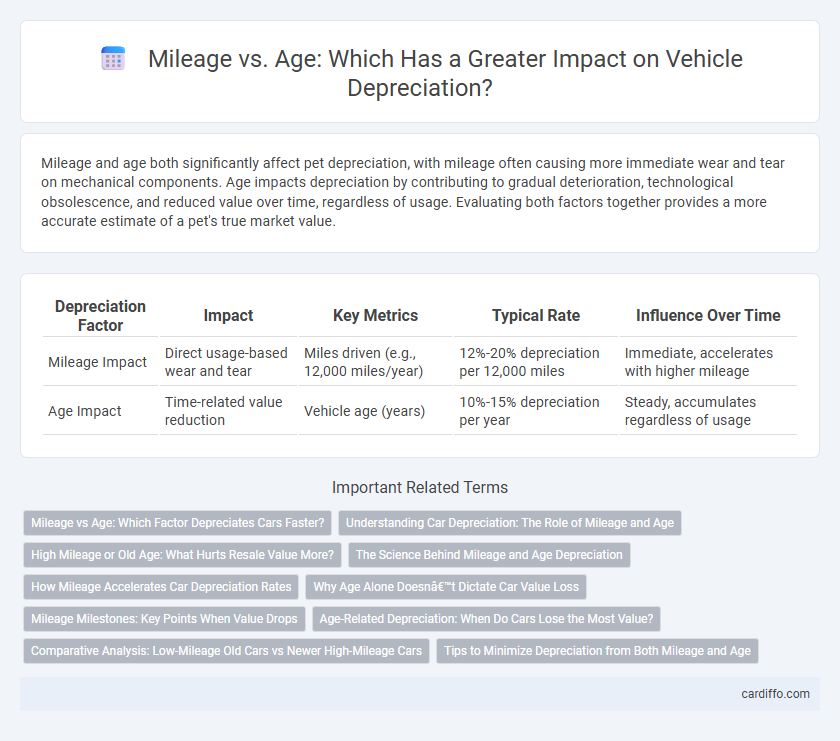Mileage and age both significantly affect pet depreciation, with mileage often causing more immediate wear and tear on mechanical components. Age impacts depreciation by contributing to gradual deterioration, technological obsolescence, and reduced value over time, regardless of usage. Evaluating both factors together provides a more accurate estimate of a pet's true market value.
Table of Comparison
| Depreciation Factor | Impact | Key Metrics | Typical Rate | Influence Over Time |
|---|---|---|---|---|
| Mileage Impact | Direct usage-based wear and tear | Miles driven (e.g., 12,000 miles/year) | 12%-20% depreciation per 12,000 miles | Immediate, accelerates with higher mileage |
| Age Impact | Time-related value reduction | Vehicle age (years) | 10%-15% depreciation per year | Steady, accumulates regardless of usage |
Mileage vs Age: Which Factor Depreciates Cars Faster?
Mileage generally accelerates car depreciation more significantly than age, as higher mileage indicates increased wear and tear, diminishing the vehicle's resale value. While age affects depreciation through technological obsolescence and outdated features, excessive mileage directly correlates with mechanical deterioration and higher maintenance costs. Data from automotive industry studies show vehicles with over 100,000 miles often lose value faster than similarly aged cars with lower mileage.
Understanding Car Depreciation: The Role of Mileage and Age
Car depreciation is significantly influenced by both mileage and age, with mileage often accelerating value loss due to wear and tear. Vehicles with higher mileage typically experience steeper depreciation compared to those with lower mileage but similar age. Understanding the nuanced impact of these factors helps buyers and sellers accurately assess a car's current market value.
High Mileage or Old Age: What Hurts Resale Value More?
High mileage typically has a more significant negative impact on a car's resale value than age, as excessive miles indicate wear and tear on critical components like the engine and transmission. Vehicles with high mileage often face accelerated depreciation due to potential maintenance costs and reduced reliability perceived by buyers. While older cars experience age-related depreciation, low-mileage older vehicles can retain higher resale value compared to high-mileage counterparts of the same age.
The Science Behind Mileage and Age Depreciation
Depreciation of a vehicle is influenced by both mileage and age, with mileage reflecting actual wear and tear on mechanical components while age accounts for the loss of value due to technological obsolescence and market perception. Scientific studies show that mileage impacts depreciation exponentially, as increased miles lead to higher probabilities of mechanical failures and maintenance costs, whereas age depreciation often follows a logarithmic decay due to slower value loss after an initial steep drop. Understanding the distinct yet interrelated effects of mileage and age enables more accurate vehicle valuation models and better financial planning for ownership costs.
How Mileage Accelerates Car Depreciation Rates
Mileage significantly accelerates car depreciation rates by increasing wear and tear, which reduces the vehicle's market value faster than age alone. High mileage indicates more extensive use, leading to increased likelihood of mechanical issues and costly repairs that deter potential buyers. Studies show cars with over 100,000 miles depreciate up to 30% faster than comparable models with lower mileage despite similar age.
Why Age Alone Doesn’t Dictate Car Value Loss
Mileage impacts car depreciation by reflecting actual wear and tear, whereas age alone fails to capture the vehicle's usage and maintenance history. Cars with low mileage often retain higher resale value despite being older, demonstrating that age without context provides an incomplete assessment of condition. Therefore, mileage is a more precise metric for evaluating depreciation than age alone.
Mileage Milestones: Key Points When Value Drops
Vehicle value often experiences significant depreciation once it crosses key mileage milestones such as 50,000, 75,000, and 100,000 miles. Mileage impacts resale value by reflecting wear and tear more directly than vehicle age, making high-mileage vehicles less attractive to buyers despite a younger model year. Understanding these critical mileage thresholds helps sellers price accurately and buyers assess long-term value and maintenance costs.
Age-Related Depreciation: When Do Cars Lose the Most Value?
Cars experience the most significant age-related depreciation within the first three years, typically losing 50-60% of their original value during this period. Unlike mileage impact, which gradually reduces a vehicle's worth, age-related depreciation accelerates rapidly when the car transitions from new to used status. This steep decline is driven by market perception, technological obsolescence, and warranty expiration, making age a dominant factor in vehicle value loss.
Comparative Analysis: Low-Mileage Old Cars vs Newer High-Mileage Cars
Low-mileage old cars often retain higher value compared to newer high-mileage cars due to slower wear on critical components despite their age. Age impact accelerates depreciation through factors like outdated technology and design, whereas mileage directly correlates with mechanical wear and tear. Market analysis reveals buyers frequently prioritize mileage over age when assessing depreciation, valuing lower mileage as an indicator of longer vehicle lifespan.
Tips to Minimize Depreciation from Both Mileage and Age
Regular maintenance and timely servicing significantly reduce mileage-related depreciation by preserving vehicle performance and preventing wear. Storing the car in a controlled environment limits age-related damage, such as paint fading and rust, thus maintaining its value longer. Combining gentle driving habits with protective measures like waxing and using sunshades minimizes overall depreciation from both mileage and age impacts.
Mileage Impact vs Age Impact Infographic

 cardiffo.com
cardiffo.com